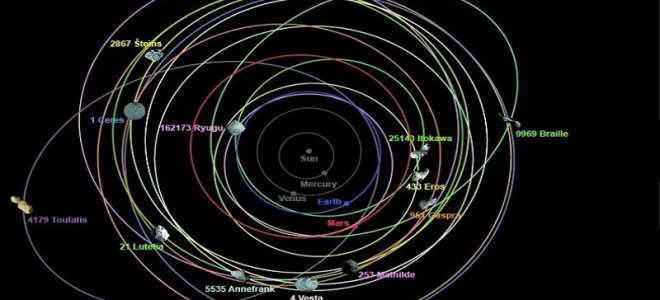
What sets the orbits of asteroids apart from those of other celestial bodies? It is common knowledge that all objects within our solar system orbit around the Sun. However, understanding the precise mechanics of their movements in space is a concept that eludes many. In reality, each celestial body follows a distinct trajectory and path. Take, for instance, the planets within our star system, which move in a nearly circular plane.
Today, we will delve into the unique path and trajectory that asteroids follow.
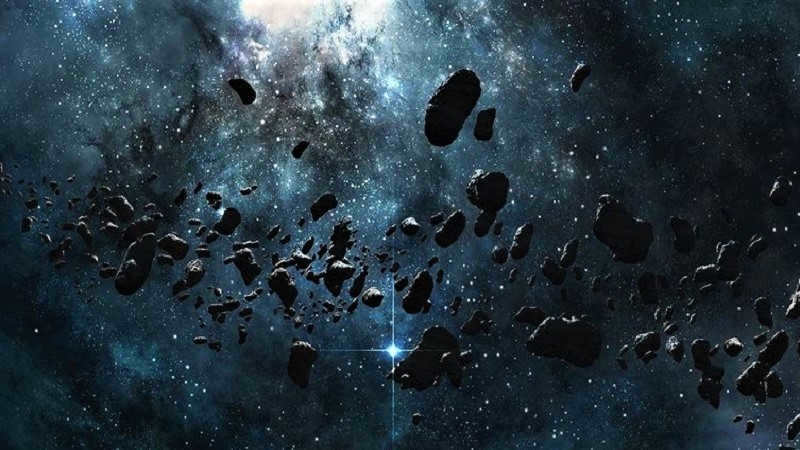
What is the primary location of most asteroids?
Primarily, the orbits of asteroids are under the influence of the Sun and planets. However, the planets are not affected by them in terms of their own motion.
It is important to mention that asteroids have varied trajectories. Nevertheless, they are significantly affected by the gravitational force of Jupiter and Mars. Since the density of objects in space decreases as the distance from the Sun increases, their trajectories are altered by the gravitational forces exerted by other planets.
As known, the majority of asteroids are situated in the main asteroid belt, which lies between Mars and Jupiter. However, there are also others that can be found throughout the entire solar system.
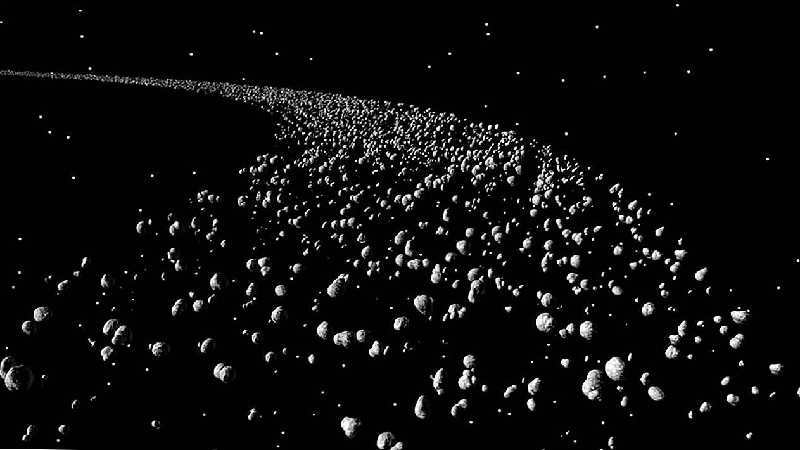
Understanding the Orbits of Asteroids
In general, the paths followed by asteroids are not perfectly circular, but rather take the shape of an ellipse. At times, their trajectories even form intricate patterns. However, the smaller the eccentricity value, the closer the orbit resembles a circle.
Typically, the eccentricity is less than 0.3, with most falling between 0.1 and 0.8. Additionally, the inclination of these orbits does not exceed 16 degrees.
In order for asteroids to maintain their orbital size, it is necessary for them to maintain a certain speed. If this speed were to decrease, they would be pulled towards the nearest planet or star due to the force of gravity.
Classification
Classification is primarily based on the division into groups and families. The former are characterized by being scattered and independent, while the latter are more closely connected.
One example of this classification is seen in Jupiter, which has two distinct groups known as the Greeks, located 60 degrees ahead of the planet, and the Trojans, located 60 degrees behind.
Most asteroid families are found within the region between the orbits of Mars and Jupiter. However, there are also families that exist outside of this area, such as the Transneptunian family in the Kuiper belt. Additionally, the orbit of the asteroid Pallada and its counterparts is significantly different from the main belt due to its large inclination.
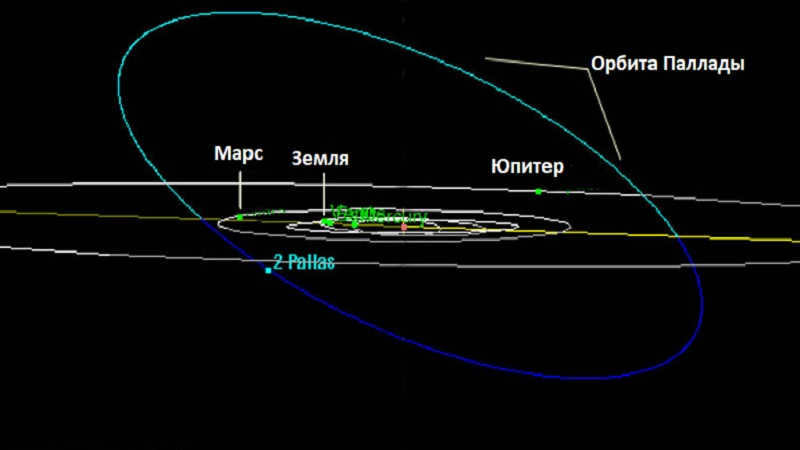
Meanwhile, it is uncommon for groups that orbit the Sun in the same path as the planet Jupiter to intersect with it. In fact, there are empty spaces, known as Kirkwood gaps, where no asteroids are found. These gaps were discovered by an astronomer named Kirkwood.
Certain asteroid objects rarely approach Jupiter and actively avoid collisions by maintaining a resonance with the planet. For instance, in the main belt groups, the most common resonance is 1:1. By moving in sync with the orbital period of the planet, these asteroids are able to preserve their own orbital periods.

It is worth noting that the paths of the “small planets” seem to shield them from the significant gravitational forces exerted by the larger planets. 1
It is important to remember that many of these “small planets” are located outside the primary belt. According to theory, any planet can be accompanied by minor celestial bodies, which may in turn have their own satellites.
Currently, the orbits of near-Earth asteroids are of particular interest. These asteroids come very close to our planet and can pose a threat to us. Any space object near Earth is a potential danger.
By the way, three families of near-Earth asteroids have been identified.
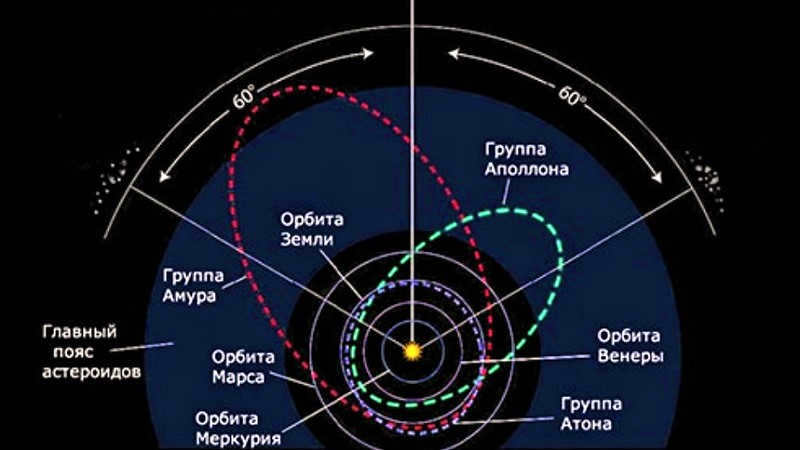
- 1221 Amur – the part of the orbit that is closest to the sun is nearly touching the Earth;
- 1862 Apollo – the part of the orbit that is closest to the sun intersects with the Earth’s orbit;
- 2962 Aton – crosses the Earth’s orbit.
Scientific investigations are ongoing in order to gain a more precise understanding of asteroid orbits and movement. The expanse of our universe is undoubtedly vast. Thankfully, thus far, spacecraft have managed to avoid collisions with minor planets. However, there is apprehension regarding the potential encounter with a substantial celestial rock. There is no denying the significance and urgency of efforts to monitor and mitigate this threat.

An asteroid is a celestial body in the solar system that orbits the Sun. It is similar to a small planet and is commonly referred to as a small planet. However, asteroids are significantly smaller in size compared to planets.
Meanings
There is a method of categorizing asteroids based on their size. According to the current classification, asteroids are considered to be objects with a diameter exceeding 50 meters, distinguishing them from meteoroids, which resemble large rocks or may even be smaller. This classification is based on the notion that asteroids have the ability to survive re-entry into the Earth’s atmosphere and make contact with its surface, whereas meteors typically burn up entirely in the atmosphere.
Consequently, we can define an “asteroid” as a celestial object within the solar system that consists of solid material and is larger in size than a meteor.
Astronomical Bodies in the Solar System
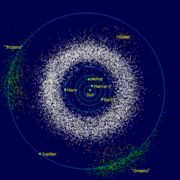
So far, the solar system has revealed tens of thousands of asteroids. As of September 26, 2006, the databases contained 385,083 objects, with 164,612 having precise orbits and being assigned an official number. At that time, 14,077 of these objects had received official names. It is estimated that there could be between 1.1 and 1.9 million objects larger than 1 kilometer in the solar system. The majority of the currently known asteroids are found within the asteroid belt between the orbits of Mars and Jupiter.
The estimated total mass of all asteroids in the main belt is 3.0-3.6×10 21 kg,[4], which accounts for only approximately 4% of the Moon’s mass. Ceres alone has a mass of 0.95×10 21 kg, which is roughly 32% of the total. Combined with the three largest asteroids, 4 Vesta (9%), 2 Pallada (7%), and 10 Hygeia (3%), these four asteroids make up 51% of the total mass. In other words, the majority of asteroids have a negligible mass.
Research on Asteroids
The exploration of asteroids commenced following the detection of the planet Uranus by William Herschel in 1781. Its average distance from the sun was determined to align with the Titius-Bode rule.
In the late 18th century, Franz Xaver von Zach formed a team of 24 astronomers with the goal of finding a planet. According to the Titius-Bode rule, this planet would be located approximately 2.8 astronomical units away from the Sun, between the orbits of Mars and Jupiter. The astronomers’ task was to record the coordinates of all the stars in the zodiacal constellations at a specific moment. On subsequent nights, they would compare the coordinates and identify objects that had moved a significant distance. The expected displacement of the planet they were searching for was around 30 angular seconds per hour, making it relatively easy to detect.
Interestingly, the initial asteroid, 1 Ceres, was accidentally discovered in 1801 by an Italian scientist named Piazzi, who was not even part of the project. This remarkable find occurred on the very first night of the new century. In the following years, three more asteroids – 2 Pallas, 3 Juno, and 4 Vesta – were also found, with Vesta being the last one discovered in 1807. Unfortunately, after an additional 8 years of unsuccessful searching, most astronomers concluded that there was nothing else to be found and abandoned the investigation.
However, Carl Ludwig Henke’s determination led him to resume his quest for new asteroids in 1830. Remarkably, just five years later, he discovered Astrea, marking the first new asteroid in 38 years. Not long after, in less than two years, he also discovered Geba. This success inspired other astronomers to join the search, resulting in the discovery of at least one new asteroid per year (excluding 1945) from then on.
Naming asteroids
In the early days, asteroids were assigned names based on figures from Roman and Greek mythology. However, as time went on, discoverers were granted the freedom to choose any name they desired, including their own. Initially, asteroids were predominantly given feminine names, with the exception of those with unique orbits, like Icarus, which is closer to the Sun than Mercury, and were assigned masculine names. However, this practice eventually fell out of favor.
Not every asteroid can be given a name, only those whose orbit can be accurately calculated. In some cases, an asteroid may not be named until many years after its discovery. Prior to calculating the orbit, the asteroid is assigned a serial number based on the date it was discovered, such as 1950 DA. The numbers in the serial number represent the year of discovery, and the first letter indicates the number of the crescent moon in that year (in the example above, it is the second half of February). The second letter represents the serial number of the asteroid within that crescent, with our example being the first discovery. Since there are 24 crescents and 26 English letters, two letters (I and Z) are not used in the designation. If the number of asteroids discovered within a crescent exceeds 24, the alphabet is recycled and the second letter is assigned the index 2, the next return receives index 3, and so on.
When an asteroid is given a name, it is typically assigned a number (in ordinal form) followed by a unique name, such as 1 Ceres or 8 Flora.
Asteroid Classification
Asteroids are generally classified based on their orbital characteristics and the way sunlight is reflected off their surfaces, which can be described by the visible spectrum.
Orbital groupings and clans
Asteroids are organized into groupings and clans based on the attributes of their orbits. A grouping is typically christened after the initial asteroid that was unearthed in a particular orbit. Groupings are relatively relaxed assemblages, whereas clans are more tightly-knit formations that arose in the past when massive asteroids were obliterated due to collisions with other entities.
Spectral classes
In 1975, a system for classifying asteroids based on color, albedo, and the characteristics of the spectrum of reflected sunlight was developed by Clark R. Chapman, David Morrison, and Ben Zellner. This classification initially defined only three types of asteroids:
- Type C – Carbonaceous, accounting for 75% of known asteroids.
- Type S – Silicate, accounting for 17% of known asteroids.
- Type M – Metallic, accounting for the majority of the remaining asteroids.
Over time, this list has been expanded and the number of types continues to increase as more asteroids are studied in detail:
It is important to note that the number of known asteroids assigned to a specific type may not reflect the actual distribution. Some types are challenging to determine, and the classification of a particular asteroid may be modified with more extensive investigations.
The initial basis for the spectral classification of asteroids was three types of materials that constitute them:
Nonetheless, there are reservations regarding the ability of this classification to definitively determine the composition of an asteroid. Although asteroids of distinct spectral classes signify varying compositions, there is no substantiation that asteroids within the same spectral class consist of identical materials. Consequently, the scientific community rejected this novel system, and the application of spectral classification ceased.
The initial 30 asteroids
Remarks
- ↑Statistics on Minor Planets. Verified on October 17, 2007.
- ↑Names of Minor Planets. Verified on October 17, 2007.
- ↑New research reveals twice as many asteroids as previously estimated. Verified on March 28, 2006.
- ↑ Krasinsky, G. A.; Pitjeva, E. V.; Vasilyev, M. V.; Yagudina, E. I. (July 2002). “Hidden Mass in the Asteroid Belt”. Icarus158 (1): 98-105. DOI:10.1006/icar.2002.6837.
- ↑ Chapman, C. R., Morrison, D., & Zellner, B. (1975). “Surface properties of asteroids: A synthesis of polarimetry, radiometry, and spectrophotometry”. Icarus25: 104-130.
- ↑McSween Jr., Harry Y. Meteorites and Their Parent Planets. – ISBN 0-521-58751-4
Citations
Related
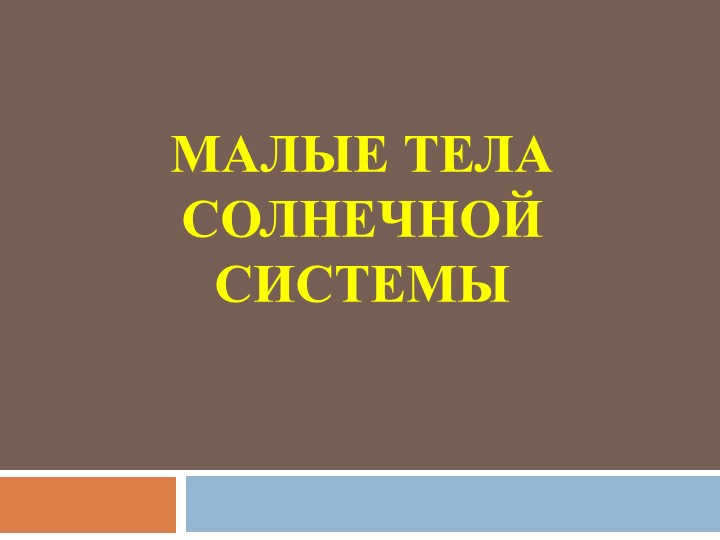
Currently, there are additional cumulative discounts (ranging from 2% to 25%) being offered to 58,742 educational institutions. In order to determine the specific discount that applies to all staff members of your educational institution, please log into your personal Infoworks account.


Advanced training program
Arranging the cultural adaptation of international students in professional education institutions.
We can apply a discount from your educational institution to this offer (the amount depends on the number of your colleagues who have completed Infoworks courses).
Currently, 58,742 educational institutions are eligible for additional discounts (ranging from 2% to 25%). To determine the applicable discount for all employees of your educational institution, please log in to your personal Infoworks account.


Advanced training program
Creating the layout and recreational area of preschool educational institution in accordance with the Federal State Standard for Preschool Education and Science (FSES)
In addition to this offer, we can include the discount provided by your educational establishment (depending on the number of your colleagues who have completed Infoworks courses).
Currently, 58,742 educational institutions are eligible for additional cumulative discounts (ranging from 2% to 25%). To determine the discount available for all staff members of your educational institution, please log in to your personal Infoworks account.


Developing reading skills in students during school lessons
Breakdown of the presentation by individual slides:

Slide 1: Diverse objects in the solar system
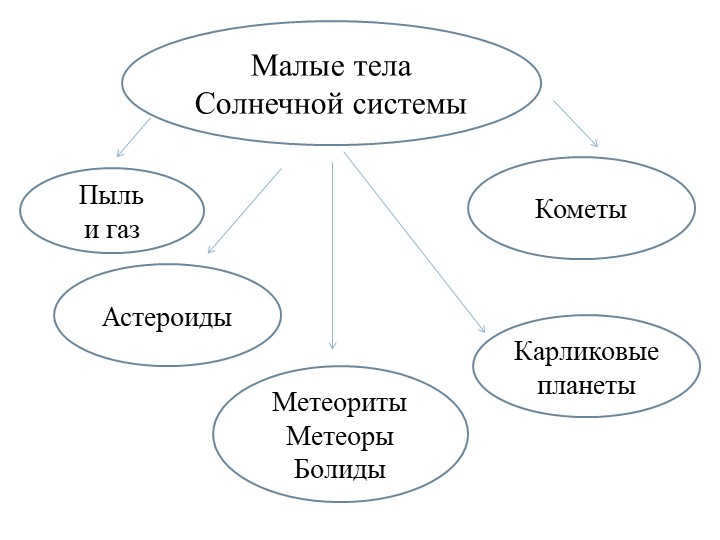
Slide 2: Various small objects in the Solar System
Asteroids
Comets
Meteorites
Meteors
Bolides
Dwarf Planets
Dust
and Gas
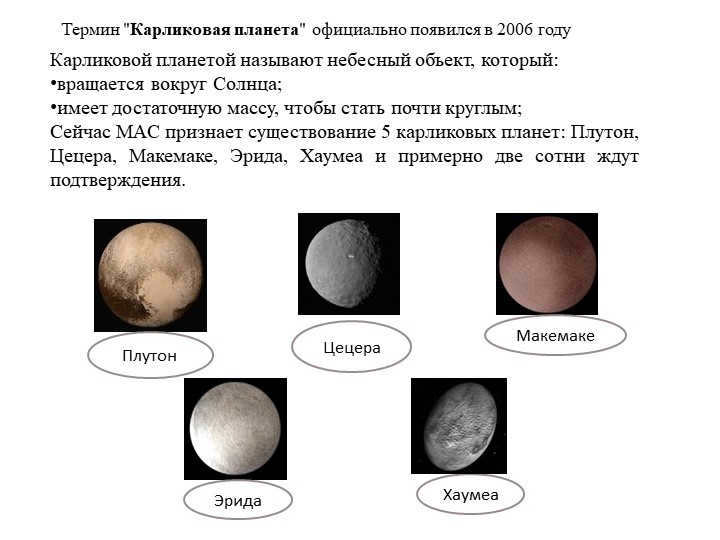
On the third slide, the term “Dwarf Planet” was officially introduced in 2006.
A dwarf planet is a celestial object that:
orbits around the Sun;
has sufficient mass to form a nearly spherical shape;
The International Astronomical Union (IAU) currently acknowledges the existence of 5 dwarf planets: Pluto, Ceres, Makemake, Eris, and Haumea, with approximately two hundred more awaiting confirmation.
Pluto
Ceres
Makemake
Eris
Haumea
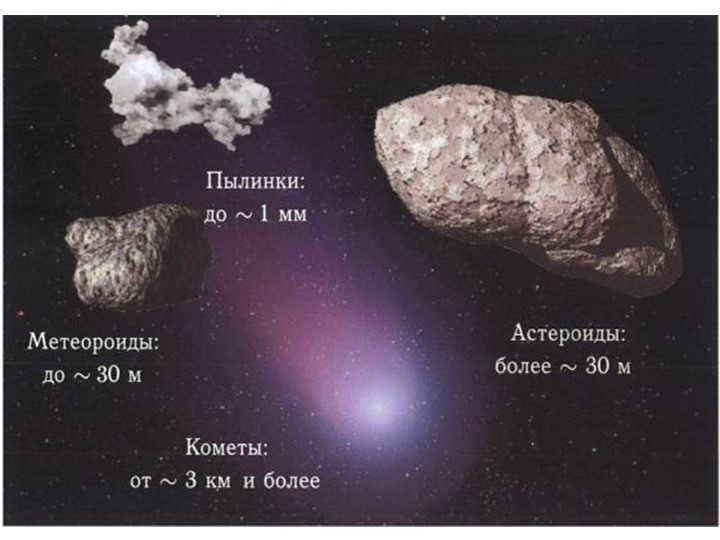
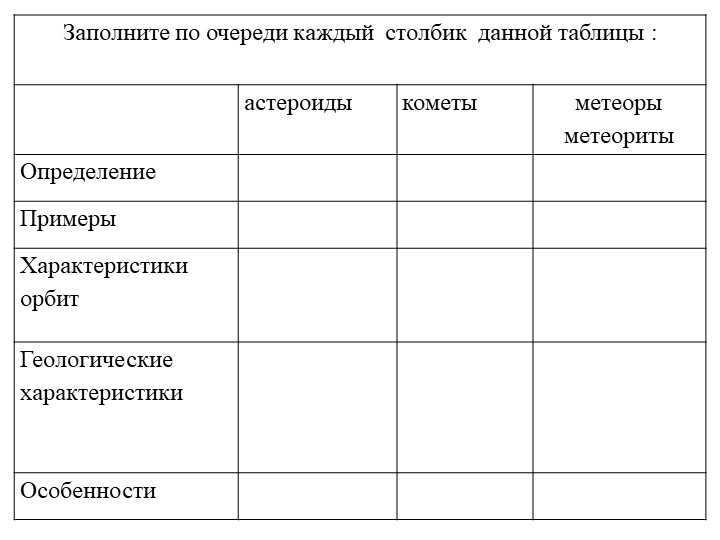
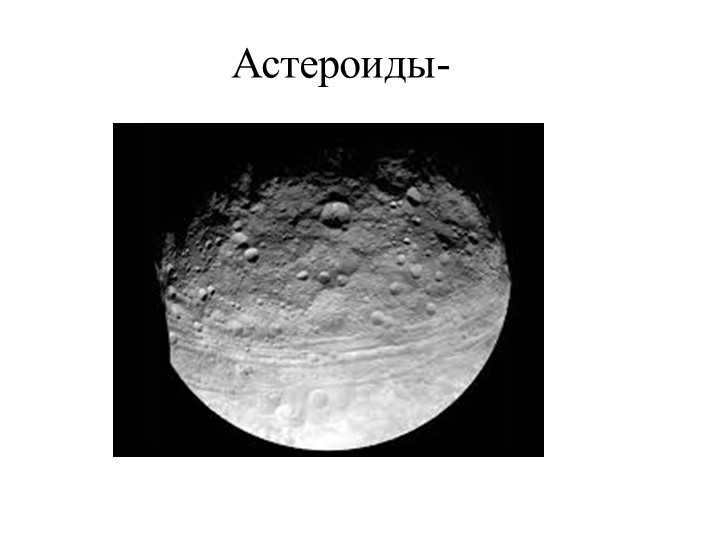
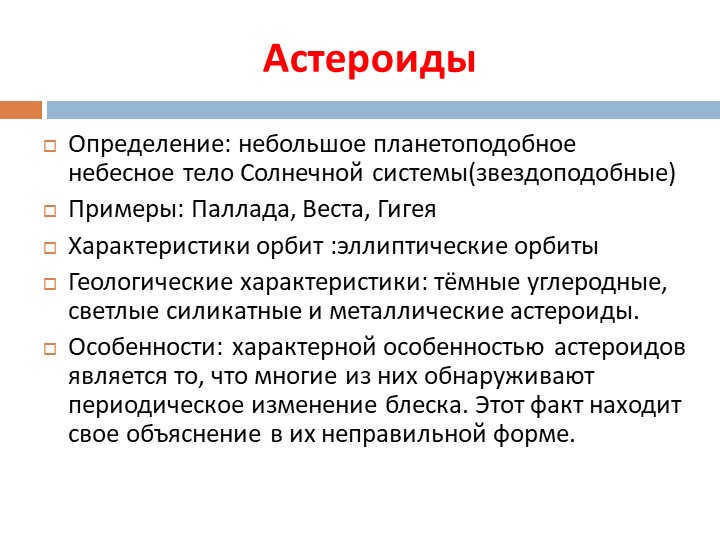
Slide 7 Asteroids
Definition: A small celestial body resembling a planet in the solar system (similar to a star).
Examples: Pallada, Vesta, Hygeia.
Orbital characteristics: Asteroids have elliptical orbits.
Geologic characteristics: Asteroids consist of dark carbon, light silicate, and metallic compositions.
Features: One notable characteristic of asteroids is their periodic change in brightness, which can be attributed to their irregular shape.
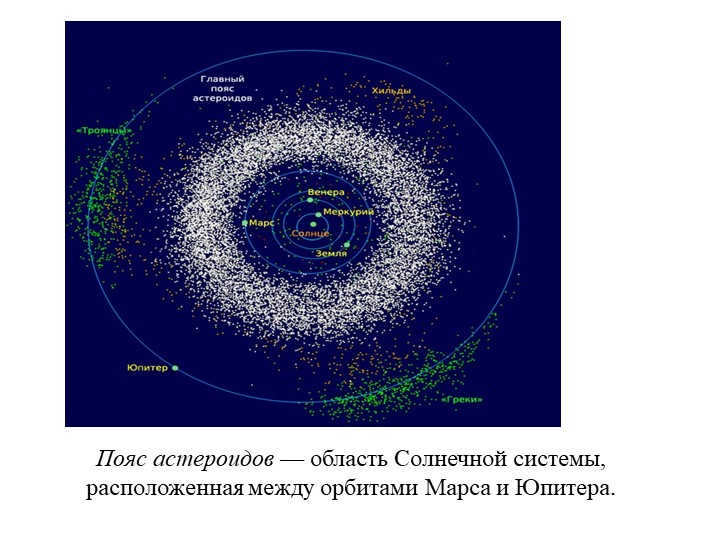
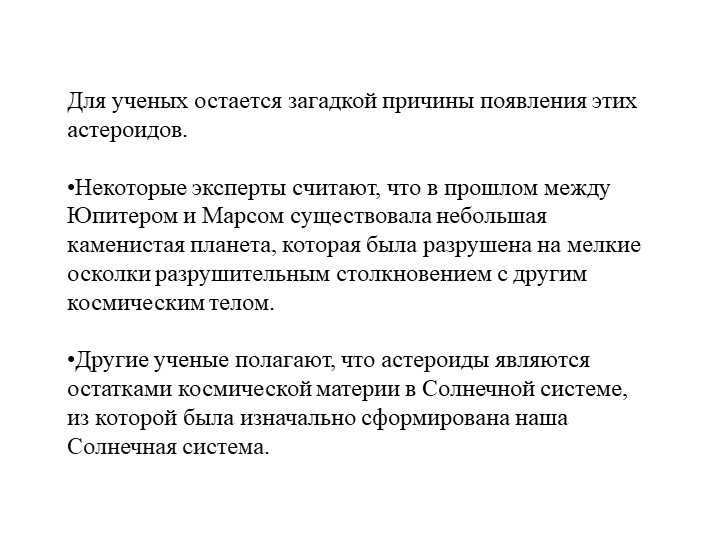
The origins of these asteroids continue to baffle scientists.
Certain specialists theorize that there was once a diminutive rocky planet situated between Jupiter and Mars that was shattered into numerous fragments as a result of a catastrophic collision with another celestial body.
Alternatively, other researchers propose that asteroids are remnants of the cosmic material present in our solar system during its initial formation.
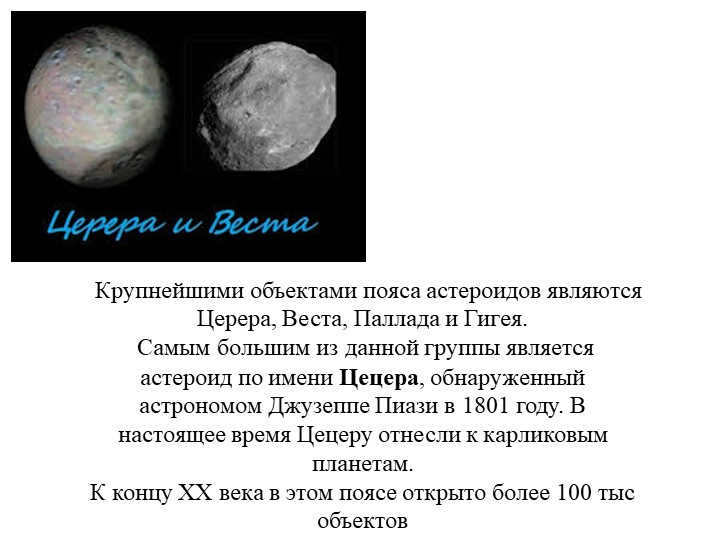
10 slide The most significant entities in the asteroid belt are Ceres, Vesta, Pallada, and Hygeia.
The most prominent among this collection is an asteroid named Cecera, which was spotted by astronomer Giuseppe Piasi in 1801. Currently, Cecera has been designated as a dwarf planet.
By the conclusion of the twentieth century, over 100,000 objects had been identified within this belt
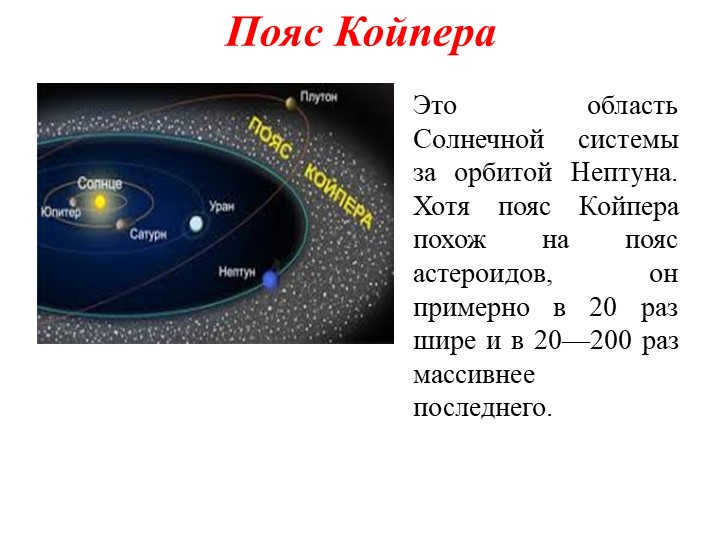
Slide 11 Kuiper Belt
The Kuiper Belt is a region in the solar system that lies beyond the orbit of Neptune. While it shares some similarities with the asteroid belt, it is significantly larger and more massive, being about 20 times wider and 20-200 times more massive than the asteroid belt.
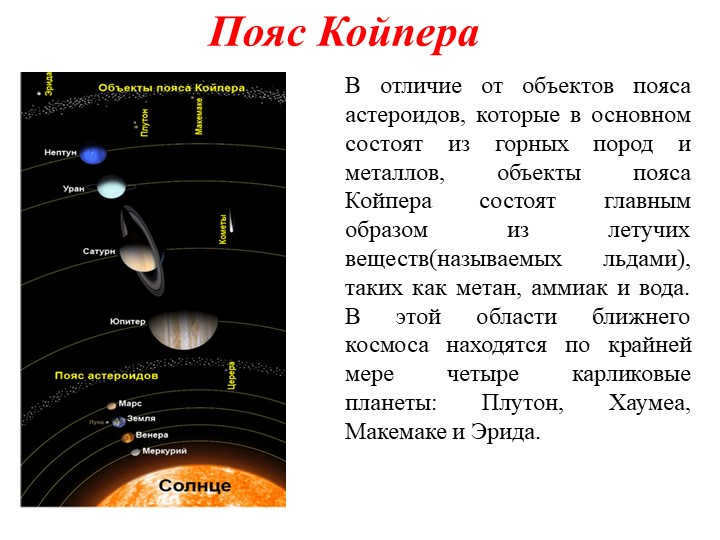
Slide 12 Kuiper Belt
Unlike the objects in the asteroid belt, which are primarily made up of rocks and metals, the objects in the Kuiper belt are predominantly composed of volatile substances, known as ice, such as methane, ammonia, and water. This region of near space is home to at least four dwarf planets: Pluto, Haumea, Makemake, and Erid.
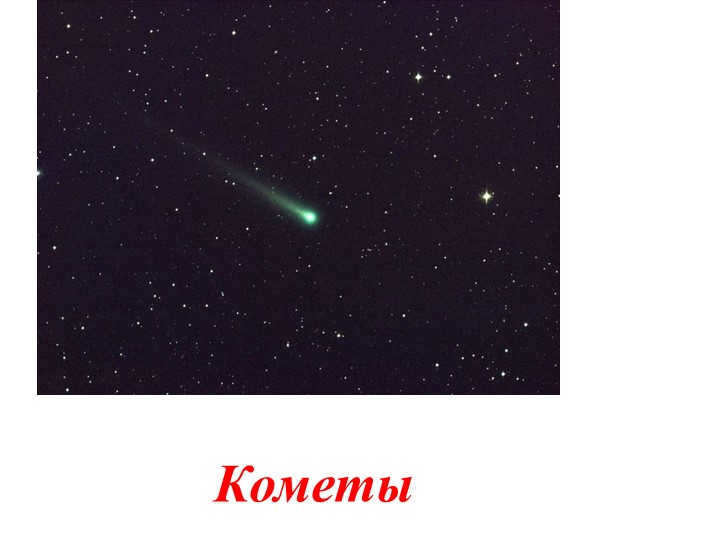
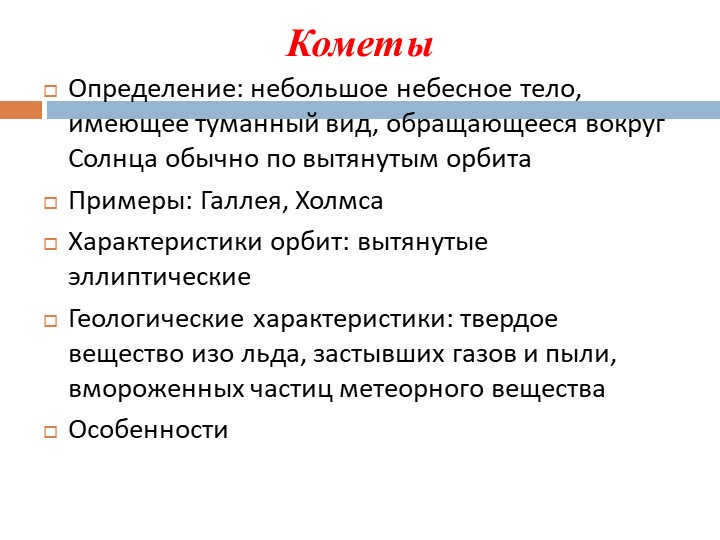
Comets are celestial bodies that orbit the Sun in an elongated orbit. They have a nebulous appearance and are composed of solid matter such as ice, frozen gases, dust, and particles of meteoric matter. Some examples of comets include Halley and Holmes. Their orbital characteristics are elongated elliptical.
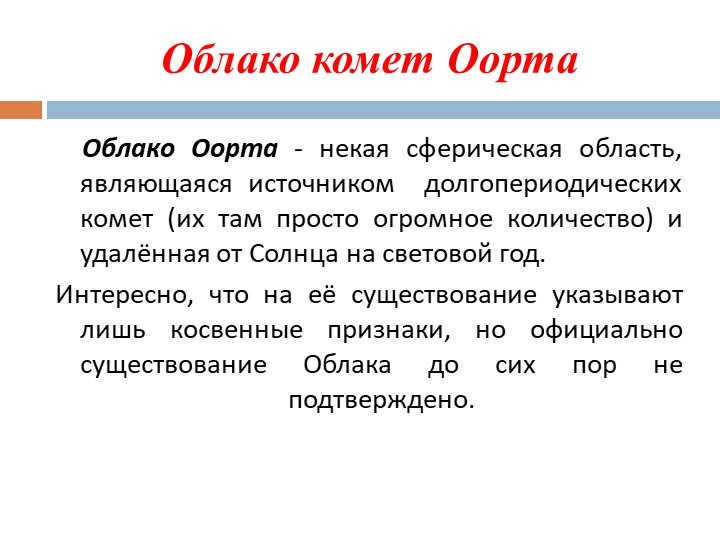

Slide 15: Oort cloud of comets
Located at a distance of a light-year from the Sun, the Oort Cloud is a spherical region that serves as the origin of numerous long-period comets. While its existence is supported by indirect evidence, official confirmation of the Cloud is still pending.
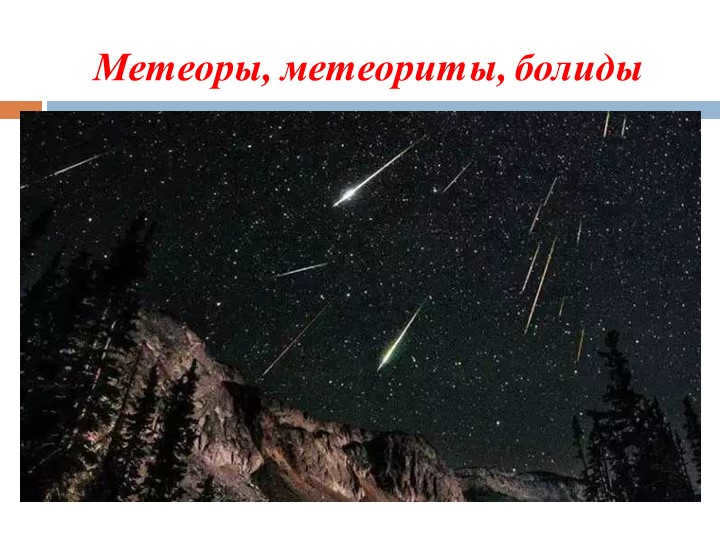
Slide 17: Meteors, Meteorites, and Bolides
Definition:
A meteor refers to the occurrence of small pebbles and grains of sand erupting in the Earth’s atmosphere when intruded from outer space. Meteoroids, on the other hand, are larger versions of these objects, measuring up to tens of meters in size.
A bolide, also known as a fireball, is a significant celestial body that enters the Earth’s atmosphere from outer space. This phenomenon is referred to as a meteoroid.
Lastly, a meteorite is a celestial body that manages to survive the journey through the Earth’s atmosphere without completely vaporizing and subsequently falls to the surface of the Earth.
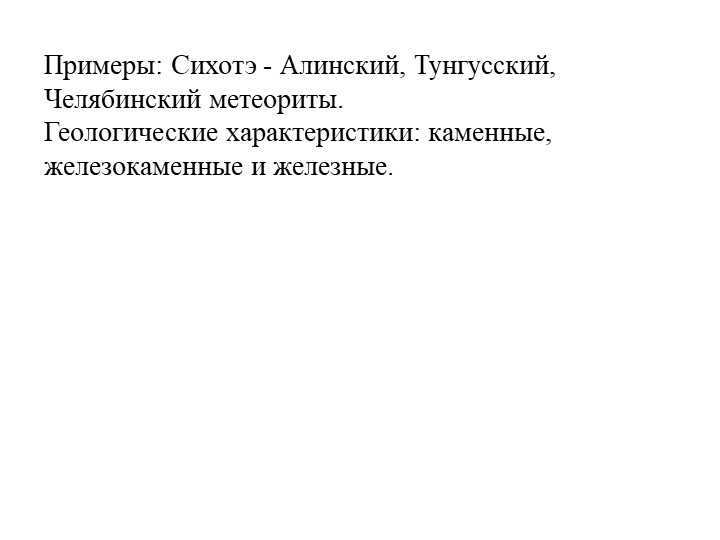
On the 18th slide, we can see some examples of meteorites such as Sikhote-Alin, Tunguska, and Chelyabinsk meteorites. These meteorites have geologic characteristics including stone, ironstone, and iron.
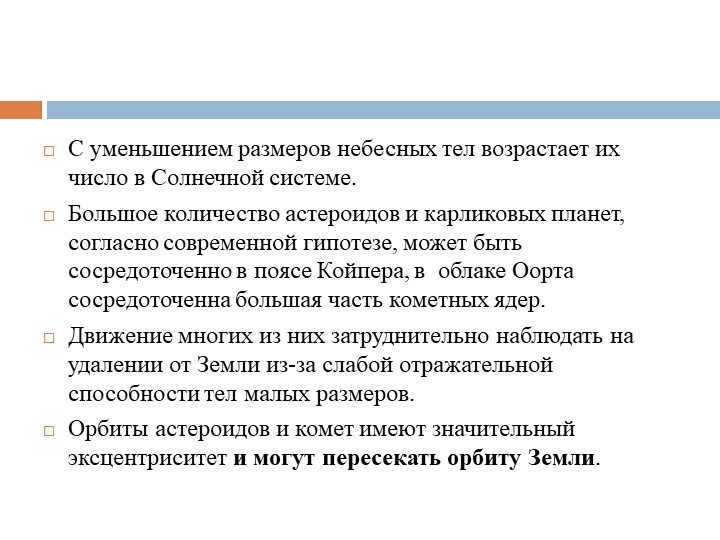
19 slide As the number of celestial bodies decreases, their size in the solar system increases.
According to the contemporary theory, a vast number of asteroids and dwarf planets may be found in the Kuiper belt, while the majority of comet nuclei are concentrated in the Oort cloud.
Due to their small size, it is challenging to observe the movement of many of these bodies from a distance because they have low reflectivity.
Asteroids and comets have highly eccentric orbits that can intersect with the Earth’s orbit.
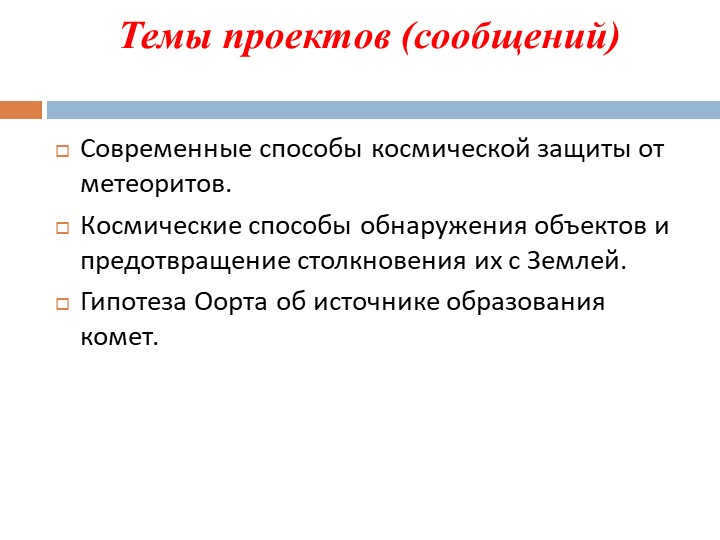
20 slide Topics of projects (messages)
Novel Approaches to Protecting Earth from Asteroids
Utilizing Space-based Techniques to Detect and Prevent Collisions with Earth
Exploring the Oort Cloud Theory on Comet Formation
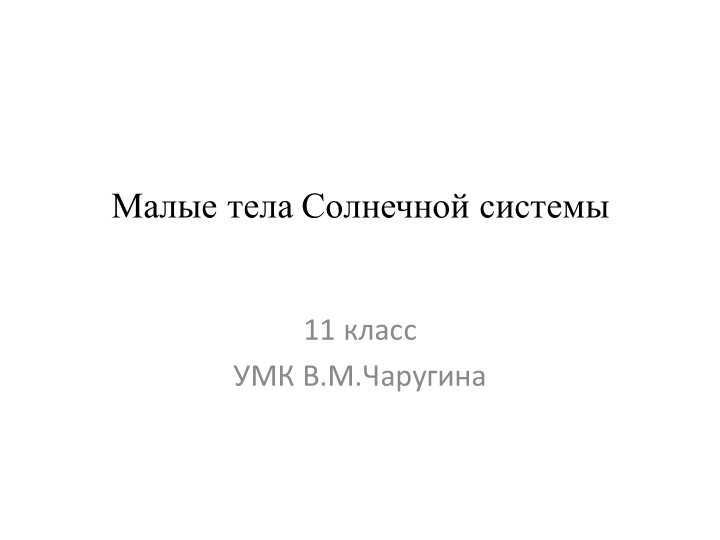
Currently, there are additional cumulative discounts (ranging from 2% to 25%) that are offered to a total of 58,742 educational institutions. To determine the specific discount that applies to all staff members of your educational institution, please login to your personal Infoworks account.


Cross-Cultural Adaptation of Foreign Students in Professional Education Institutions
A course on professional development
We can apply a discount from your educational institution to this offer (the amount will depend on the number of your colleagues who have completed Infoworks courses).
Currently, 58,742 educational institutions are eligible for additional discounts ranging from 2% to 25%. To find out the specific discount applicable to all employees of your educational institution, please log in to your personal Infoworks account.


Course for professional development
Creating the object and play space of a preschool educational organization in accordance with the Federal State Educational Standard for the Development of Preschool Education
We can combine your educational institution’s discount with this discount (it will depend on how many of your colleagues have already taken Infowork courses).
Currently, 58,742 educational institutions are receiving additional discounts (ranging from 2% to 25%). To find out what discount is available for all employees of your educational institution, please log in to your personal Infoworks account.


Developing reading skills in students during class time
Summary of the presentation in separate slides:

Slide 1: Examination of Small Celestial Objects in the Solar System
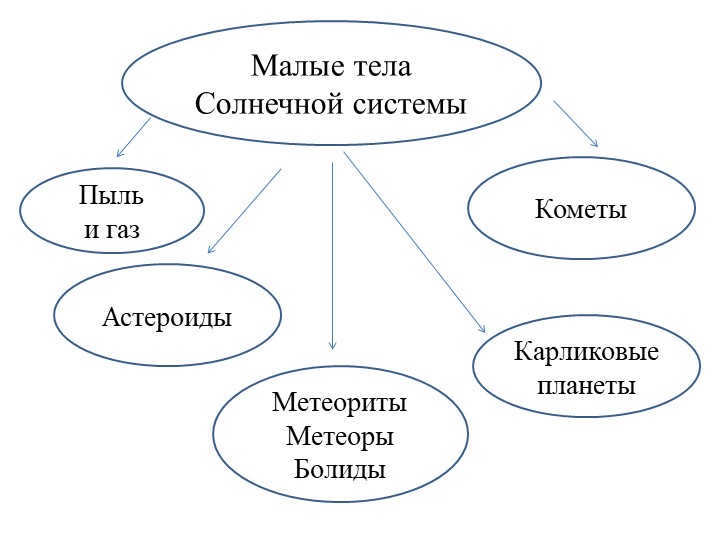
Slide 2: Small celestial objects in our solar system
Asteroids
Comets
Meteorites
Meteors
Bolides
Dwarf
planets
Dust
and gas
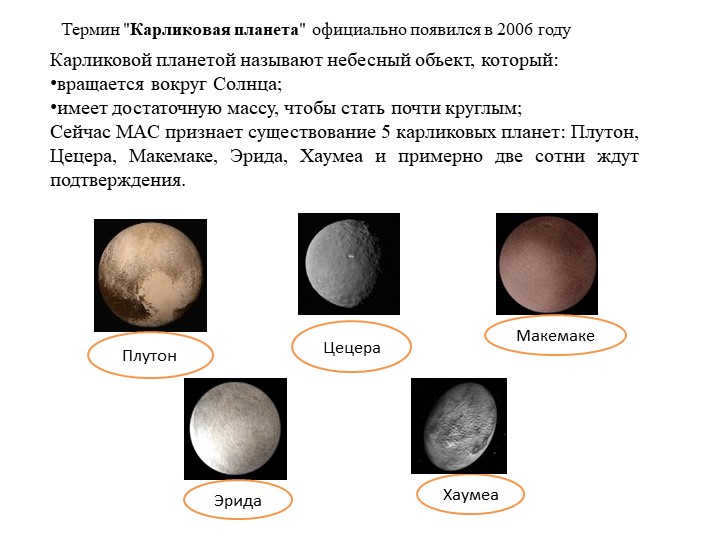
3 slide The concept of “Dwarf Planet” was formally established in 2006
A dwarf planet is an astronomical body that:
orbits around the Sun;
has sufficient mass to achieve nearly spherical shape;
The International Astronomical Union (IAU) now officially acknowledges the presence of 5 dwarf planets: Pluto, Ceres, Makemake, Eris, Haumea and approximately two hundred others are awaiting confirmation.
Pluto
Ceres
Makemake
Eris
Haumea
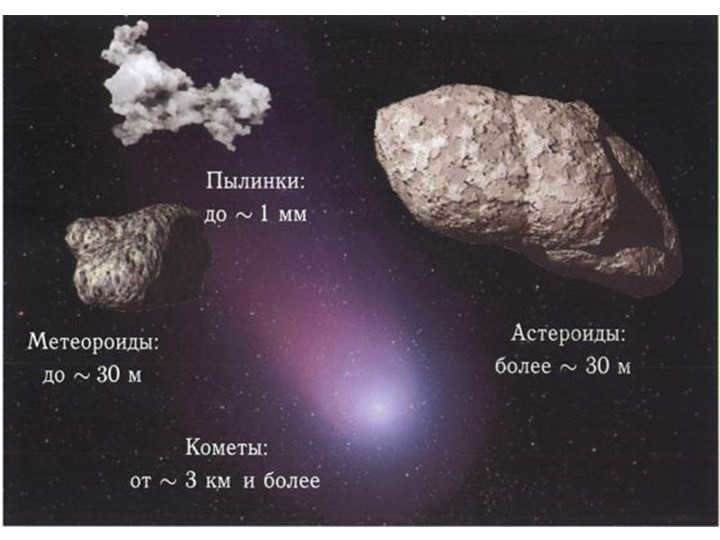
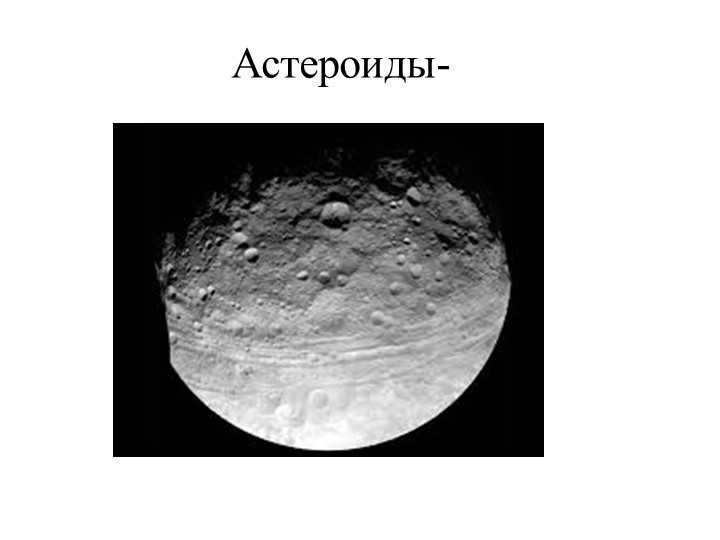
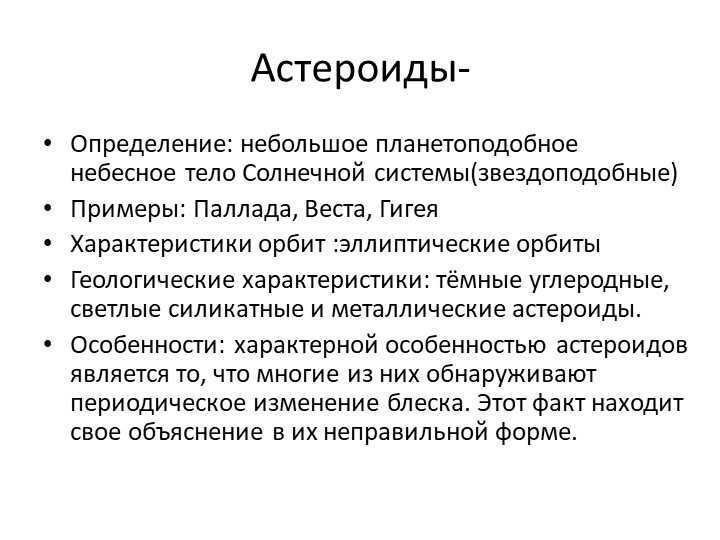
7 slide Asteroids-.
Definition: A small celestial body similar to a planet in the solar system (resembling a star).
Examples: Pallada, Vesta, Hygeia.
Orbital characteristics: Elliptical orbits.
Geologic characteristics: Dark carbon, light silicate, and metallic asteroids.
Features: One notable feature of asteroids is that many of them exhibit periodic variations in brightness. This phenomenon can be attributed to their irregular shape.
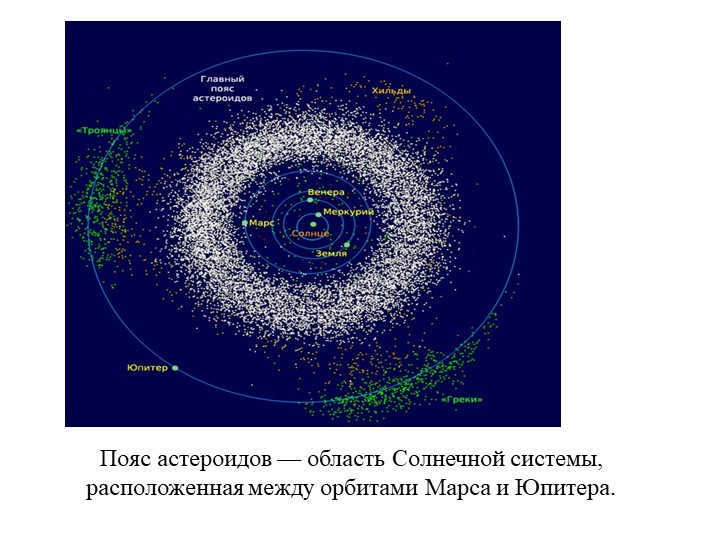
Scientists still do not know what causes these asteroids.
According to some experts, there used to be a small rocky planet between Jupiter and Mars. It is believed that this planet was destroyed when it collided with another object in space, resulting in the formation of numerous asteroid fragments.
On the other hand, some scientists propose that asteroids are actually remnants of cosmic matter that existed in the early stages of our solar system’s formation.
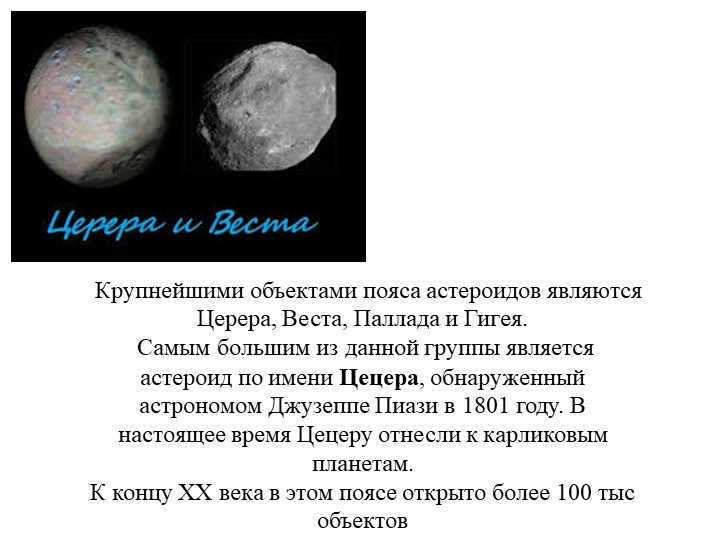
Slide 10: Ceres, Vesta, Pallada, and Hygeia are the most prominent members of the asteroid belt.
Among them, Cecera stands out as the largest asteroid, which was first spotted by astronomer Giuseppe Piasi in 1801. Today, Cecera is officially classified as a dwarf planet.
Throughout the twentieth century, scientists have identified over 100,000 celestial bodies within this belt
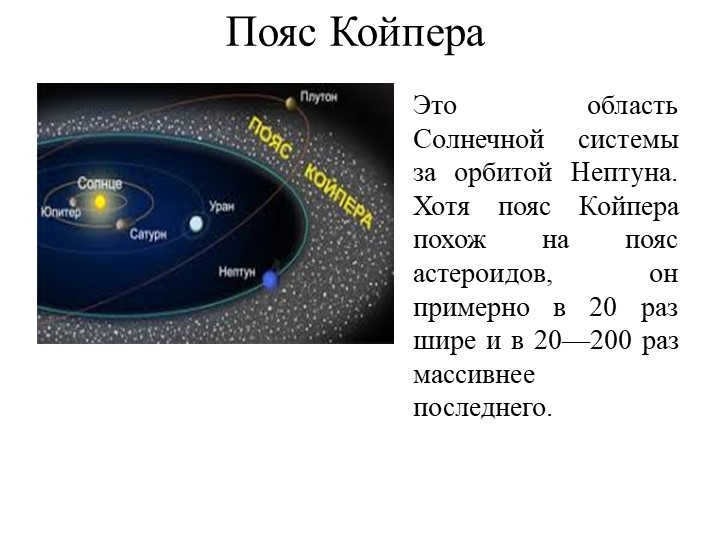
Slide 11 Kuiper Belt
The Kuiper Belt is an area in our solar system that is located beyond the orbit of Neptune. It shares some similarities with the asteroid belt, but it is much larger, being approximately 20 times wider and 20-200 times more massive.
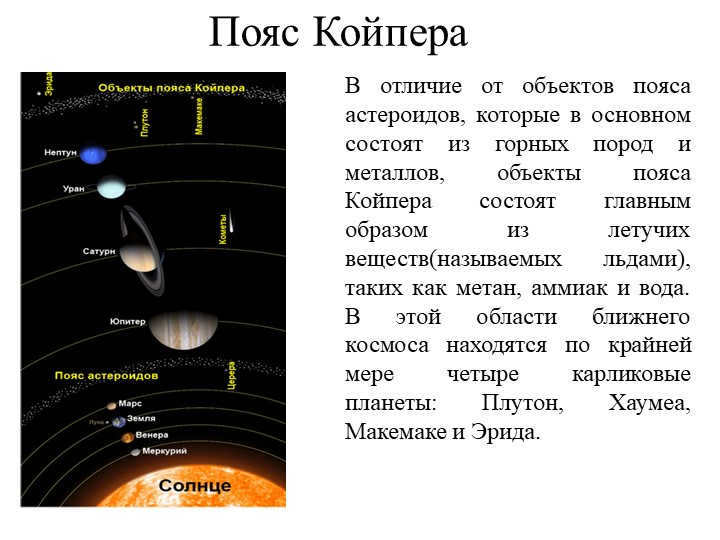
Slide 12: Kuiper Belt
The Kuiper Belt, in contrast to objects found in the asteroid belt, consists primarily of volatile substances known as “ice,” such as methane, ammonia, and water. Within this region of space, there are at least four dwarf planets: Pluto, Haumea, Makemake, and Erid.
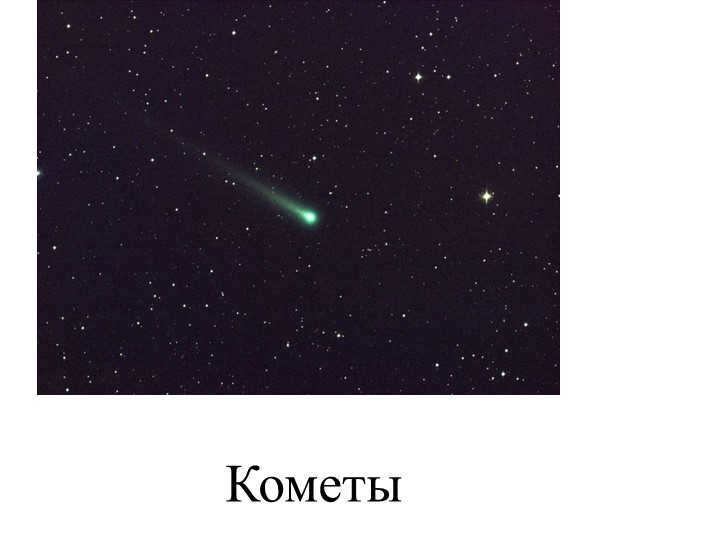
Slide 14 Comets.
What are they: Comets are celestial bodies that orbit the Sun in a stretched-out path, giving them a hazy appearance.
Some examples: Halley, Holmes.
Orbiting features: Their orbits are elongated and elliptical in shape.
Geological composition: Comets are made up of solid matter, such as ice, frozen gases, dust, and frozen particles of meteoric matter.
Distinctive attributes
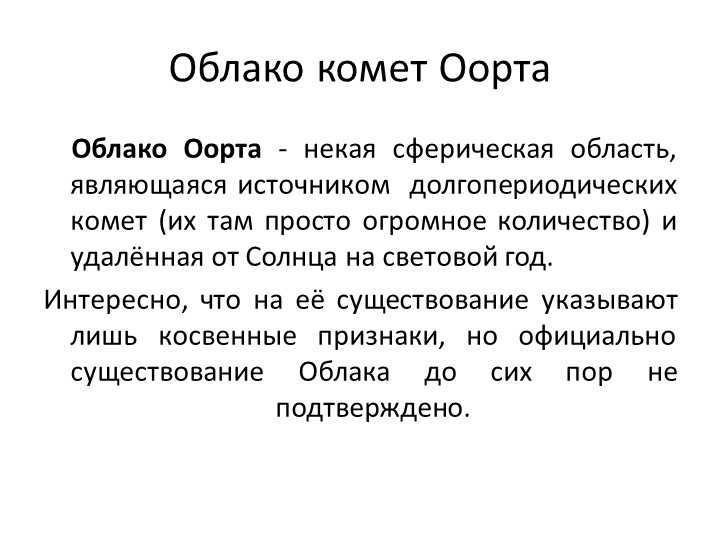
On the 15th slide, we will be discussing the Oort cloud of comets. The Oort Cloud is a spherical region that serves as the origin of long-period comets (it is home to a vast number of them) and is located at a considerable distance from the Sun, spanning over a light year. It is worth noting that the existence of the Oort Cloud has only been inferred through indirect evidence, and its official confirmation is still pending.
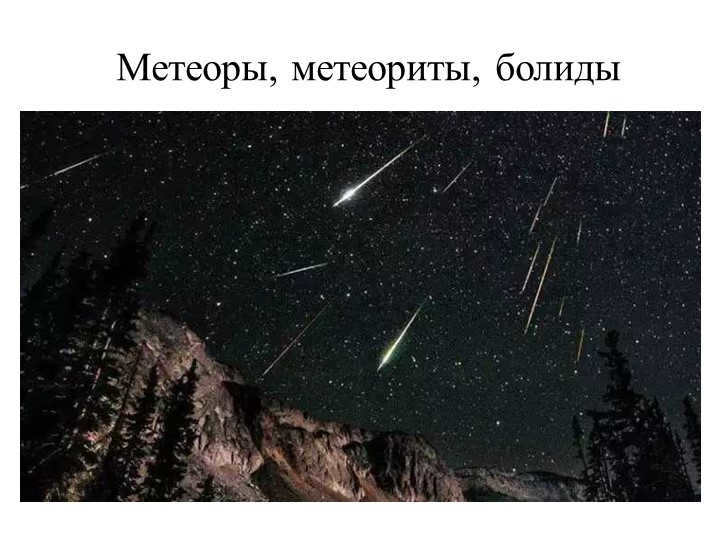
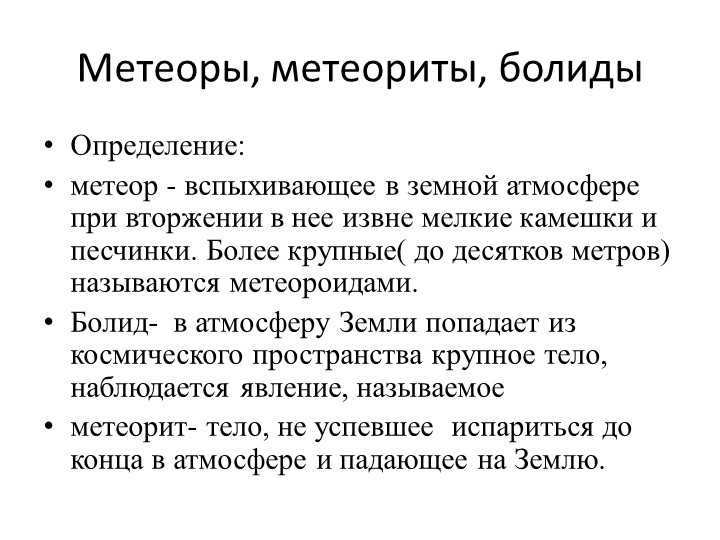
Slide 17 Meteors, meteorites, and bolides
Definition:
A meteor is when small pebbles and grains of sand in the Earth’s atmosphere are ejected from outside. Meteoroids, which can be as large as tens of meters, are considered larger forms of meteors.
A bolide refers to a large celestial body that enters the Earth’s atmosphere from outer space. When a bolide does not completely vaporize in the atmosphere, it becomes a meteorite and falls to the Earth.

On slide 18, we can see some examples of meteorites such as Sikhote-Alin, Tunguska, and Chelyabinsk. These meteorites can be classified into three types based on their geological characteristics, which are stone, ironstone, and iron.
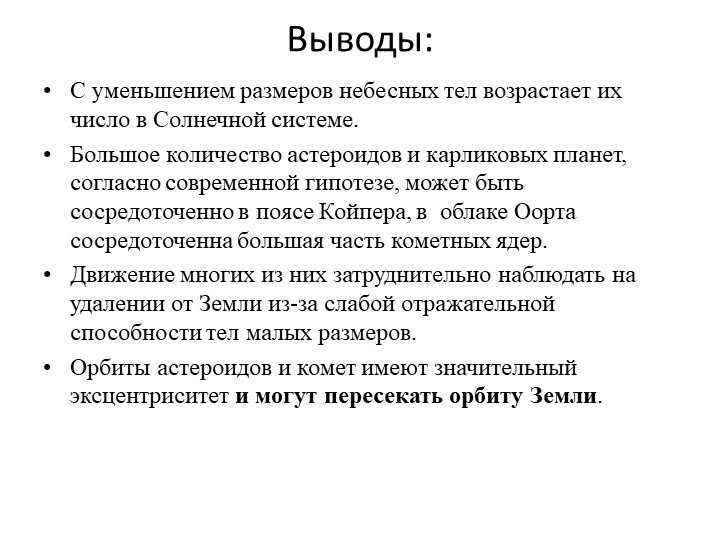

Slide 19 Conclusions:
As the size of celestial bodies reduces, their number in the Solar System increases.
Based on the modern hypothesis, it is believed that a significant number of asteroids and dwarf planets may be concentrated in the Kuiper belt, while most of the cometary nuclei are concentrated in the Oort cloud.
Observing the motion of many of these celestial bodies from a distance can be challenging due to their small size and low reflectivity.
Asteroids and comets have orbits with significant eccentricity and can intersect with the Earth’s orbit.
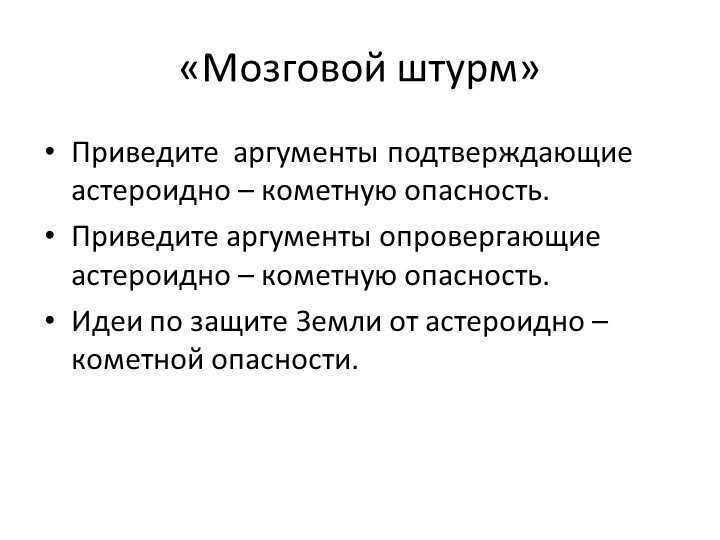
In the 20th slide of the “Brainstorming”, we will discuss the arguments that confirm the danger of asteroids and comets. Additionally, we will explore the arguments that refute this danger. Lastly, we will brainstorm ideas on how to protect the Earth from the potential threats posed by asteroids and comets.
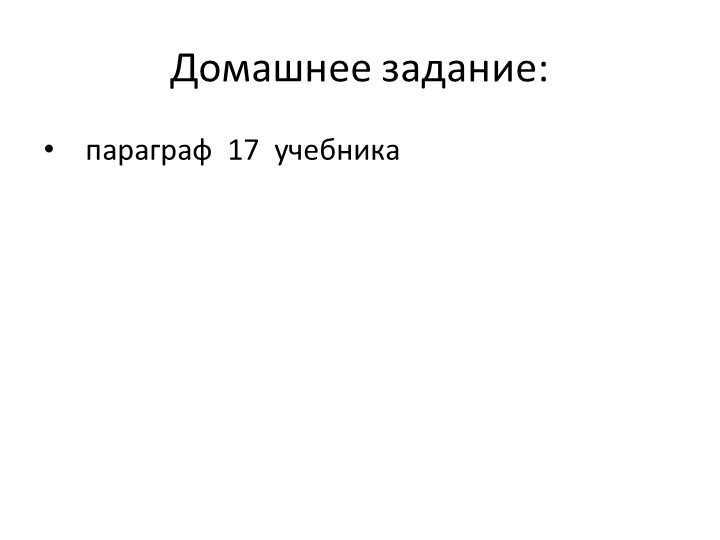
22 slide Themes of projects (messages)
Modern methods of space defense against meteorites.
Space methods of detecting objects and preventing their collision with the Earth.
The Oort hypothesis about the source of comet formation.
Asteroids serve as important tools for understanding the universe and also pose a potential threat to Earth. On International Asteroid Day, we bring you information about the largest, most valuable, hazardous, and captivating asteroids.
“Emerald Comet.”
The “emerald comet,” also known as the 60-kilometer asteroid Asporina, is renowned among astronauts and astronomers alike. Olivine, a vibrant green mineral, covers the surface of this celestial body. Interestingly, olivine is a key component of the lunar regolith.
(246) Asporina (Latin: Asporina) is a main belt asteroid that falls into the rare spectral class A. French astronomer Alphonse Borelli discovered it on March 6, 1885, at the Marseille Observatory. Asporina is named after one of the goddesses worshipped in Asia Minor.
Chicxulub, situated on the Yucatan Peninsula in Mexico, stands as a testament to the devastating impact of an asteroid that wiped out the dinosaurs.
Approximately 65 million years ago, a meteorite collided with Earth, creating the massive Chicxulub crater. Despite being relatively young compared to other prominent craters, scientists believe that this catastrophic event played a significant role, if not entirely responsible, for the extinction of the dinosaurs. The scale of this cataclysmic event was immense, with researchers suggesting that the impact triggered a tsunami with waves reaching heights of up to 100 meters.
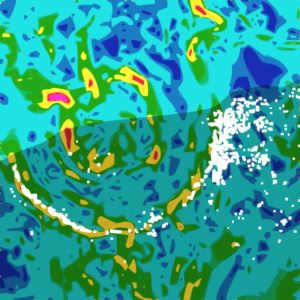
The planet was covered by a dust cloud, which prevented the sun’s rays from reaching the surface. This led to a significant decrease in the Earth’s air temperature. It is extremely challenging to determine the exact extent of the catastrophe and the original size of the crater today. Over millions of years, the area where the meteorite fell has constantly changed due to erosion and other geological factors. Some scientists even suggest that the original diameter of the crater could have been as large as 300 km. Currently, the visible diameter of the crater is approximately 180 km.
It was found relatively recently, in 1987, during an expedition conducted to explore oil reserves. Consequently, scientists stumbled upon a symmetrical arc located at the depths of the Gulf of Mexico, which was also present on the land.
This event altered the course of life on our planet. As commonly known, the consequences of this event were long-lasting. Dinosaurs, along with numerous other species, became extinct, paving the way for the emergence of what could be considered the most perilous creature of all – humans.
Ida, an asteroid, has a companion.
Previously, it was believed that only larger celestial bodies, such as full or dwarf planets, could have satellites. The concept of another body orbiting an asteroid was purely theoretical. However, advancements in astronomical observations have revealed the existence of triple systems involving small cosmic bodies, like asteroid (87) Silvia. The groundbreaking discovery came when the Galileo probe captured images of asteroid (243) Ida and its companion, Dactyl. This finding revolutionized our understanding of cosmic bodies and contributed to the development of theories regarding meteorites falling to Earth.
Ida is situated at a distance of 2.862 astronomical units from the Sun, which is equivalent to almost three times the distance between the Sun and Earth, or approximately 428 million kilometers.
People on Earth are eagerly anticipating the arrival of a special delivery from the asteroid Ryugu.
Ryugu, also known as (162173) Ryugu, is a representative member of the Apollo group of near-Earth asteroids. It falls into the dark spectral class C and possesses an elongated orbit that not only intersects with the orbit of Mars, but also intersects with Earth as it travels around the Sun.
Last year, Japan’s Hayabusa2 spacecraft had the incredible opportunity to explore this unique diamond-shaped celestial body. During its mission, the spacecraft collected a sample from the surface of Ryugu with the intention of bringing it back to Earth. The analysis of this material is expected to provide valuable insights into the formation of the solar system and potentially shed light on the origins of life on our own planet.
Ryugu was first detected in 1999 during the Lincoln Near-Earth Asteroid Research (LINEAR) initiative, a collaborative effort in the United States aimed at cataloging and monitoring celestial objects. The Japanese space agency JAXA approximates the asteroid’s size to be around 900 meters in width (although some scientists have suggested a slightly smaller diameter). Positioned in an orbit between Earth and Mars, Ryugu occasionally intersects Earth’s path, qualifying it as a “potentially hazardous” asteroid, although it currently poses no immediate threat to our planet. As per JAXA, the asteroid completes a full rotation every 7-8 hours as it traverses through space.
The asteroid is referred to as “dragon palace” in Japanese, which is a name derived from a Japanese fairy tale about a magical underwater castle. In this tale, a fisherman explores the palace and brings back a mysterious box, much like the enigmatic specimens that will be brought back to Earth by Hayabusa2. Interestingly, all the notable features of this small asteroid, including its craters and rocks, are named after stories from various cultures.
Vesta: A Colossal Asteroid that Poses No Threat to Earth
(4) Vesta is a behemoth within the main asteroid belt, boasting an impressive mass and size. In fact, it holds the top rank among all asteroids in these categories. Prior to Ceres being classified as a dwarf planet, Vesta held the esteemed position as the third largest asteroid in terms of size, trailing only Ceres and Pallada. Additionally, Vesta claimed the second spot in terms of mass, with Ceres taking the lead.
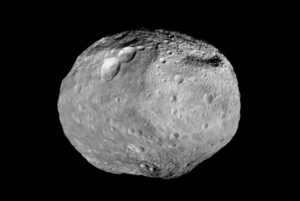
Furthermore, it happens to be the most luminous asteroid out of the entire group and the sole one that can be easily seen without the aid of any instruments. Vesta was initially detected on March 29, 1807 by Heinrich Wilhelm Olbers and given the name Vesta, in honor of Vesta, the ancient goddess of household and family, following Carl Gauss’ recommendation.
Asteroid (16) Psyche stands out as a remarkable celestial object: it ranks among the top 10 largest bodies in the asteroid belt. With a diameter measuring 226 kilometers, it boasts an impressive size.
Psyche 16 captivates scientists due to its exceptionally high concentration of metallic elements. Approximately 90% of the asteroid consists of iron and nickel, and there are even speculations that it may contain enough gold and platinum to significantly impact the global economy if these precious metals could be extracted and brought to Earth.
Unlike most other asteroids, which are predominantly composed of silicate minerals (S-type) or carbonaceous compounds (C-type), Psyche 16’s composition of nickel and iron classifies it as a metallic asteroid (M-type).
Psyche is presently the biggest asteroid in the M-type group. This has resulted in numerous conclusions within the astronomical field that Psyche is, in fact, a fragment of the core of a planet. It is possible that 16 Psyche is the uncovered planetary core of a small celestial body that has endured numerous intense impacts, causing its mantle to disintegrate and expose the core. NASA is currently making preparations for a mission to investigate this phenomenon.
Apophis, the asteroid that will come close to Earth
Apophis, also known as asteroid (99942), grabbed the attention of scientists right after its discovery in 2004. What caused the alarm was the initial calculation of its orbit, which indicated a potential collision with Earth in 2029. With its massive size, measuring several hundred meters, the impact of Apophis could result in a significant regional or even global catastrophe.
However, further refinement of Apophis’ trajectory has ruled out a collision in 2029. Instead, the asteroid will pass by at a distance of approximately 37,000 kilometers from the Earth’s center. Nevertheless, there is still a possibility of close approaches or impacts in the future, with 2036 being the most likely year for such an event. Experts are actively researching and studying the potential for a collision.





